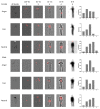Features and Extra-Striate Body Area Representations of Diagnostic Body Parts in Anger and Fear Perception
- PMID: 35447997
- PMCID: PMC9028525
- DOI: 10.3390/brainsci12040466
Features and Extra-Striate Body Area Representations of Diagnostic Body Parts in Anger and Fear Perception
Abstract
Social species perceive emotion via extracting diagnostic features of body movements. Although extensive studies have contributed to knowledge on how the entire body is used as context for decoding bodily expression, we know little about whether specific body parts (e.g., arms and legs) transmit enough information for body understanding. In this study, we performed behavioral experiments using the Bubbles paradigm on static body images to directly explore diagnostic body parts for categorizing angry, fearful and neutral expressions. Results showed that subjects recognized emotional bodies through diagnostic features from the torso with arms. We then conducted a follow-up functional magnetic resonance imaging (fMRI) experiment on body part images to examine whether diagnostic parts modulated body-related brain activity and corresponding neural representations. We found greater activations of the extra-striate body area (EBA) in response to both anger and fear than neutral for the torso and arms. Representational similarity analysis showed that neural patterns of the EBA distinguished different bodily expressions. Furthermore, the torso with arms and whole body had higher similarities in EBA representations relative to the legs and whole body, and to the head and whole body. Taken together, these results indicate that diagnostic body parts (i.e., torso with arms) can communicate bodily expression in a detectable manner.
Keywords: Bubbles paradigm; EBA; bodily perception; diagnostic body parts; fMRI.
Conflict of interest statement
The authors declare no conflict of interest.
Figures














Similar articles
-
Maintenance of Bodily Expressions Modulates Functional Connectivity Between Prefrontal Cortex and Extrastriate Body Area During Working Memory Processing.Brain Sci. 2024 Nov 22;14(12):1172. doi: 10.3390/brainsci14121172. Brain Sci. 2024. PMID: 39766371 Free PMC article.
-
Linear Representation of Emotions in Whole Persons by Combining Facial and Bodily Expressions in the Extrastriate Body Area.Front Hum Neurosci. 2018 Jan 10;11:653. doi: 10.3389/fnhum.2017.00653. eCollection 2017. Front Hum Neurosci. 2018. PMID: 29375348 Free PMC article.
-
Representational Similarity of Body Parts in Human Occipitotemporal Cortex.J Neurosci. 2015 Sep 23;35(38):12977-85. doi: 10.1523/JNEUROSCI.4698-14.2015. J Neurosci. 2015. PMID: 26400929 Free PMC article.
-
Functional atlas of emotional faces processing: a voxel-based meta-analysis of 105 functional magnetic resonance imaging studies.J Psychiatry Neurosci. 2009 Nov;34(6):418-32. J Psychiatry Neurosci. 2009. PMID: 19949718 Free PMC article. Review.
-
Neural Underpinnings of the Perception of Emotional States Derived From Biological Human Motion: A Review of Neuroimaging Research.Front Psychol. 2018 Sep 21;9:1763. doi: 10.3389/fpsyg.2018.01763. eCollection 2018. Front Psychol. 2018. PMID: 30298036 Free PMC article. Review.
Cited by
-
Maintenance of Bodily Expressions Modulates Functional Connectivity Between Prefrontal Cortex and Extrastriate Body Area During Working Memory Processing.Brain Sci. 2024 Nov 22;14(12):1172. doi: 10.3390/brainsci14121172. Brain Sci. 2024. PMID: 39766371 Free PMC article.
-
A broadly tuned network for affective body language in the macaque brain.Sci Adv. 2022 Nov 25;8(47):eadd6865. doi: 10.1126/sciadv.add6865. Epub 2022 Nov 25. Sci Adv. 2022. PMID: 36427322 Free PMC article.
References
-
- Barrett L.F., Mesquita B., Gendron M. Context in Emotion Perception. Curr. Dir. Psychol. Sci. 2011;20:286–290. doi: 10.1177/0963721411422522. - DOI
Grants and funding
LinkOut - more resources
Full Text Sources

